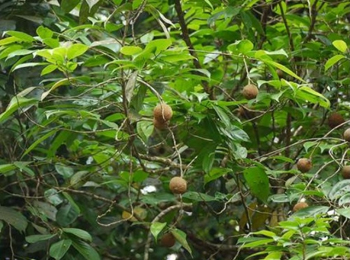Tuvaraka (Hydnocarpus laurifolia)

Description of Plant
Tuvaraka is an evergreen deciduous tree which can grow up to 16 m or more in height. Bark is rough, brown and wood whitish but generally becomes brownish-grey due to fungal sap-stain and turns streaked. Leaves are oblong, ovate or elliptic, somewhat serrate and 10-16 cm long. Flowers of this herb are small, solitary fascicles and greenish white. Fruits are globose, mammilate, tomentose and 5.1-10.2 cm diameter. It bears the fruits between the months of August and September. Seeds are striate, sub ovoid, obtusely angular and 2.0- 2.5 cm. long. Flowering occurs from January to April.
General Information
Tuvaraka herbs has the great medicinal importance in ancient Ayurveda. This herb is known to be very effective to treat the skin diseases. Use of Tuvaraka is very effective in the treatment of leprosy. This herb is loaded with the antimicrobial antipyretic, wounds healing and curative properties. Furthermore this herb helps in purification of blood and quite effective to resolve the urinary tract infection. Hypnocarpic, chaulmoogric and its homologues, gorlic, oleic and palmitic acids, anigenin, luteolin, chrysocnisol, hydnocarpin, isohydnocarpin and methoxy hydnocarpin are the chemical constituents present in this herbs. These chemical compounds offer the various health benefits in the treatment of various ailment and also offer the other health benefits.
Habitat
The plants are found in the mountains of Western Ghats from Maharashtra to Kerala and is also found in the hilly regions of Assam and Tripura. It is also cultivated in Uganda, Nigeria, Sri Lanka and few other South East Asian countries.
Classification
- Kingdom – Plantae
- Order - Malpighiales
- Family - Flacourtiaceae
Names
- Latin name - Hydnocarpus laurifolia
- Sanskrit name – Tuvaraka, Turveraka, Tuvrak, Kushtavairi
- English name – Soorty oil tree
- Hindi name – Chalmogra, Chalmoogra, Jangali badam
- Bengali name – Choulmogara
- Kannada name – Garuda Phala
- Marathi name – Kadu Kaveet
- Malayalam name – Kodi
- Tamil name – Maravattai
- Farsi name – Phiranjamogra
- Telugu name – Adavi Badam
Ayurvedic Properties
| Hindi / Sanskrit | English | ||
| Rasa | Katu, Tikta, Kashaya | Taste | Astringent Pungent, Bitter |
| Guna | Snigdha, Tiksna | Physical Property | Unctuous, Sharp |
| Virya | Ushna | Potency | Hot |
| Vipaka | Katu | Metabolic Property (After Digestion) | Pungent |
Effects on Doshas
It is used to manage the kapha and vata ailments.
| Charak Samhita | Sushrut Samhita | Prabhava |
Nil |
Ubhayatobhagahara |
Ubhayatobhagahara |
References
The Bhavprakash nighantu with elaborated Hindi commentary by Padmashri prof. K.C. Chunekar, edited by Dr. G.S. Pandey: edition of 1998: page no- 826-827.
Practical Uses of Hydnocarpus Laurifolia
- Tuvaraka is kwon to be very effective herb to treat the skin problems. Use of this herb is quite effective to manage the symptoms of skin infections like psoriasis, ring worm, eczema and scabies. It helps in the natural healing of wounds.
- Bark of Tuvaraka contains tannins which has the anti-pyretic properties and provides relief in fevers.
- This herb is loaded with the blood purification properties. Thus it is used in the treatment of Leprosy since ages. Dressing with this herb is quite good to relieve scaly eruptions and other syphilitic skin disorders.
- Use of this herb is quite effective in the treatment of urinary tract infections. This herb can also be used as a vaginal disinfectant in problem of fetid discharge and gonorrhea which occur after child birth.
- Seed powder of Tuvaraka is good in the problems of dizziness, lightheadedness. Thus this herb helps to energize the body.
- Use of this herb is also good to resolve the digestive disorders like helmithiasis, ascites. It is emetic, purgative and anthelmintic.
- Use of this herb is quite beneficial to manage the diabetes. It helps to manage the increased blood sugar levels in the body. Furthermore it also help to control the release of sugar in urine.
- This is quite beneficial in the treatment of cholera.
- Tuvaraka is considered as an effective herb to resolve the lungs and respiratory complications. It helps to clear phlegm and mucous from nasal passages, respiratory tracts and bronchial tubes. Thus this herb is quite beneficial in the treatment of chest congestion, nasal congestion, bronchitis and tuberculosis.
- Various other health issues like lymphadenopathy, fistula and bone ulcers, rheumatoid arthritis, and gout can also be resolved with the use of this herb.
- This herb also good in rheumatism as it helps to provide relief in the swelling, pain, redness, inflammation of the legs, hands and joints.
Parts Used
Seed and seed oil.
Dosage
05-60 drops



